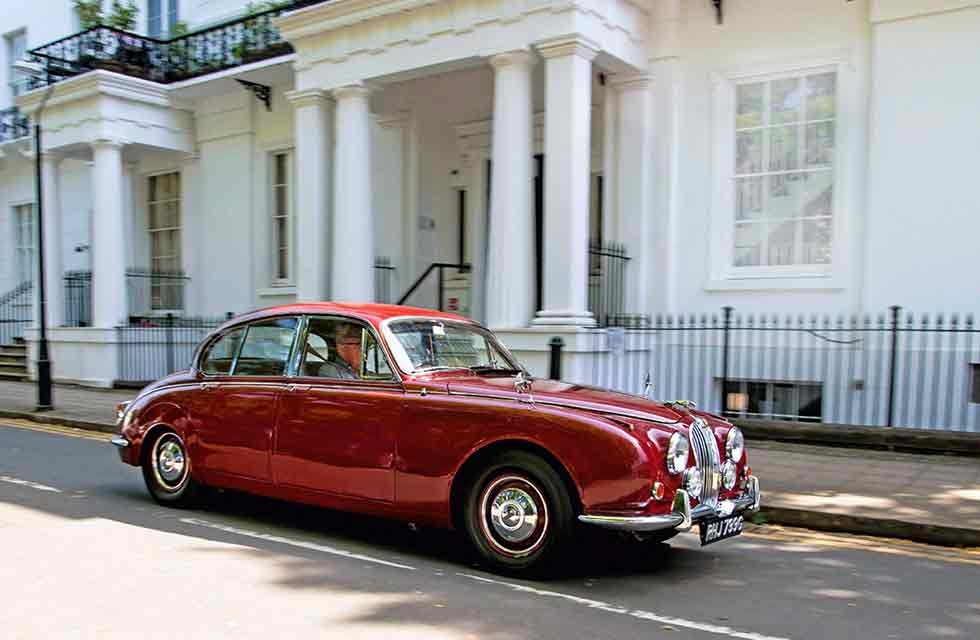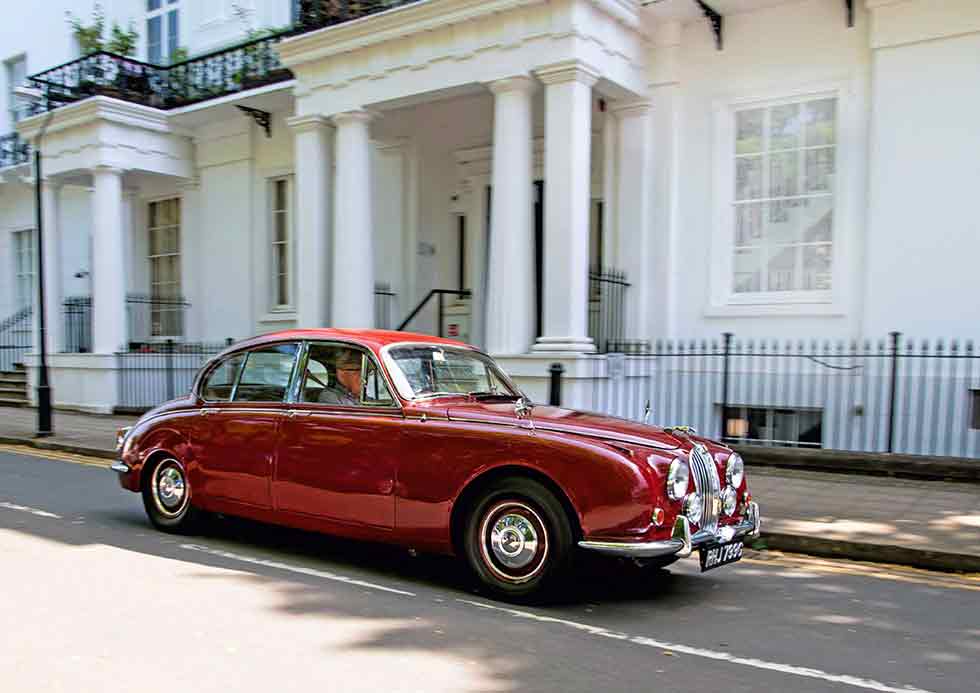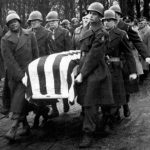
On the road in the Jaguar that once transported rock stars around London. This Jaguar 240 ferried pop royalty around London and bore witness to the birth of glam rock. Four decades on, we relive its glittery past. Words Sam Dawson. Photography Jonathan Jacob.
Dedicated Follower of Fashion Out on the town in the Jaguar 240 of Colin Wild, flamboyant costumier to the stars, who created the look of Seventies Glam Rock
On a Thursday evening early in March 1971, a young woman in a beige raincoat emerges from Oxford Circus tube station into the drizzle and gloom. She’s about to make a dash across Regent Street when, amid the four-star smog and fluttering stray envelopes left undelivered by the recent postal strike, a Regency Red Jaguar 240 lurches up between the lights, gleaming in the raindrops. Cars like this aren’t an uncommon sight in this part of London. They’re the natural choice of moneyed professionals, police officers and establishment types. But this 240 isn’t. A box trailer hangs from a towbar, jiggling over ruts in the road behind it, a strangely mundane task for such a prestigious car. Then the pencil-thin chromed wipers sweep the windscreen, revealing the front-seat occupants. She double-takes. The driver’s seat is taken by a towering Edwardian-styled dandy, well over six feet tall, sporting a ginger beard, elaborate moustache and monocle along with his elegantly tailored pinstriped three-piece suit with tailcoat, cravat and silk handkerchief.

The wipers judder their way across the ’screen again, and she eyes the figure reclining languidly in the passenger seat this time. Male, she assumes, but with long dark hair in extravagant ringlets, and wearing a black satin blouse of a kind that can’t be bought in high-street shops. She meets his gaze briefly through the side window as the traffic lights go green and the Jaguar slides away down Oxford Street with a lounge-lizard purr. The image of heavy eyeliner, glitter-glue smeared beneath, sticks in her mind as within moments, the aliens are gone, back into the string of dull-hued BL, GM and Ford fodder shuffling its way out towards Bayswater.
‘The 2.4-litre XK straight-six pulls noisily away and settles to a deep, sonorous thrum at urban-crawl speeds’
A couple of hours later, it all makes sense. Even though she’s watching in black and white, Marc Bolan is unmistakeable on Top of the Pops that night, studio lights turning his face and clothes into sweeping lighthouse-beam reflectors. The music press quickly labels this new style Glam Rock, and Bolan’s band, T-Rex, enjoys a six-week reign at the top of the charts with Hot Love. Today, I’m driving that very Jaguar 240 passers-by might have glimpsed Marc Bolan riding in. Its owner, that tall, bearded dandy, was Colin Wild. He loved this car, keeping it from 1970 until his death in 1988, but he must have struggled to get in and out of it. Negotiating the big steering wheel takes practice. I have to twist my left leg and slide it across the smooth Ambla leatherette seat in order to get in. Once ensconced, my knees are splayed around the wheel, but it’s not uncomfortable. The fact that it’s an automatic helps, because my feet fall naturally in front of a pedal each.
I soon become grateful for that big wheel though. There’s no power assistance and the steering’s heavy at lowspeeds, making me grateful for the leverage the big wheel provides. Once the 2.4-litre XK straight-six has pulled noisily away and settles to a deep, sonorous thrum at urban-crawl speeds, the steering lightens up and it becomes possible to guide the car with my fingertips. There’s a dead-zone when tracking straight, but it’s perfect for urban use. Wild might not be the household name that Bolan became, but without him – and the efforts of this car – the music culture of the early Seventies would not have been as we remembered it. This Jaguar served as Wild’s personal runabout, but also – hence the towbar – an extraordinary company car and delivery van. Since 1964, together with business partner Danny Benjamin, he’d run the Carnaby Cavern. Originally a window-dresser by trade, albeit with a sideline in dancing on Top of the Pops and a contact book full of rock stars and actors, Wild branched out into alternative, unusual fashion design, tailoring and retail.
Before long Benjamin and Wild’s boutique, its Ganton Street location originally chosen on account of being cheaper than leasing a premises on nearby Carnaby Street, was the regular haunt of the likes of The Kinks, Shirley Bassey, Desmond Dekker, Alvin Stardust, Status Quo and Jimi Hendrix. They’d come to hang out in the shop’s stairwell – which soon became a rendezvous point for stars looking to avoid getting noticed on Carnaby Street, thankful for Benjamin having banned cameras from the shop – and get fitted for items like enormous detachable collars, ruffles, Cossack shirts, Nehru jackets and satin flares. Then as evening approached, they’d jump in Colin’s car, hitch up the trailer if costume changes were needed, and dash across London to concert venues, TV studios and photographers’ workshops. The car was usually kept outside Wild’s flat on nearby Poland Street most of the time. Amazingly, the Jaguar was Wild’s idea of downsizing. ‘He wasn’t really into cars,’ says owner James Utting, former historic touring-car racer and chairman of the Norfolk-region Jaguar Enthusiasts’ Club. Utting bought the car from the Wild family in 2012. ‘But in 1970, someone connected to Henly’s, the London Jaguar dealership, asked him whether he’d be interested in a 240, and he said yes.’ It was sourced via Abbott’s of Southend, where it had been registered on 29th January 1969.
Utting explains, ‘Wild had made a lot of money in a relatively short amount of time, and had a large house in the South London suburbs as well as the Poland Street flat, and a stable of five racehorses too. In the late Sixties he ran a Rolls-Royce Silver Cloud that he used for his daily commute, as well as celebrity-taxi and sample-delivery duties, but its size made it impractical. He kept the Rolls, but the 240 was the best compromise for him as a town car. He may not have been a car enthusiast, but he liked flash, and at that time celebrities wanted either a Silver Cloud or, if they liked driving themselves, a Jaguar E-type.
‘The E-type wouldn’t have worked as a trailer-hauler and Colin would have struggled to fit himself in it, let alone pop-star friends, so the 240 was the best of both worlds, especially as an automatic. It was a noticeable sight around Carnaby Street back then. Colin put whitewall tyres on it, and would take it to music and fashion events to promote the Carnaby Cavern. When I found it, the boot was still full of old flyers, fabric swatches and sample clothes.’
The Carnaby Cavern’s adverts are a delirious timewarp that established the themes around Sixties pop-culture in a manner that looks and reads like pastiche today. Hand-drawn pen-and-ink images of a shaggy-haired character described as ‘the Carnaby Cavern Man’, variously sporting a heavily ruffled shirt and flares in mod-club guise, at other times a long, collarless jacket, sunglasses and a handlebar moustache in man-about-town mode, strikes pre-ironic poses alongside a bob-cut, rollneck-wearing mod girl. He’s accompanied by proclamations like ‘At Last! He’s discovered where the Groups get their way-out gear!’ and ‘Kinky Kaftans, a must for all you ravers – multi-floral patterns for gals and guys.’
In between taking the likes of Diana Ross and Shirley Bassey out to lunch or ferrying guests to Benjamin and Wild’s Thamesmoored luxury motor-cruiser for parties, the Jaguar’s usual activities involved dashing around town between shop and venues. With so many rock stars filing in and out of the Carnaby Cavern, things could get chaotic. The Jaguar, trailer attached, was sometimes involved in cross-town dashes to facilitate lastminute costume-changes, as Status Quo’s Rick Parfitt recalled in the band’s 2005 autobiography XS All Areas, ‘He rigged everybody out in those days. However, there could be pros and cons to this. On the plus side you got to wear some of the newest, most fashionable threads in the world. On the downside, you’d go to a photo session and put on a bright yellow shirt you’d bought from Colin at the Cavern the day before, and the photographer would go, “No, you can’t wear that, Jimi Hendrix was in here last week wearing the same thing.” You’d sigh and put on another one and he’d go, “No, I did that with Andy Fairweather Low yesterday.”’
But Wild’s most enduring partnership was with Bolan and T-Rex. Although the Glam aesthetic first hit TV screens in 1970, a key aspect of its look may well have its origins in a trick pulled at the Carnaby Cavern itself, back in 1964. Faced with a bare wall in need of decoration but with no ready budget for wallpaper and paste, Wild remembered a technique he’d used creating a department-store Santa’s Grotto some years earlier, crinkling up silver foil and stapling it to the wall, creating a cheap yet effective glittery edifice. It soon became an intrinsic part of the Cavern’s design, and went on to influence Wild’s clothing designs.
While it’s no Mini Cooper, the 240 works well in Wild’s metropolitan nip-and-tuck role. A 2483cc displacement sounds extravagant nowadays when executive-class luxury saloons can get away with turbocharged four-pots, but the 2.4 was the baby of Jaguar’s XK engine range in the Sixties. In a pre-oil-crisis mindset, it acts a lot like a modern turbodiesel, with a modest slug of torque instantly available when hitting the throttle to glide away from the lights. It might have seemed uncouth compared to Wild’s whispering Silver Cloud; the lethargic Borg-Warner Type 35 automatic gearbox holds onto first gear a little too long for comfort, whining up beyond 4000rpm and sounding like a Fifties delivery truck before its perceptible shunt into second.
Once in second gear it’s remarkably tractable, my right foot surging the car along with the traffic, the engine eagerly pulling through its midrange. But two factors that make the 240 ideal for town use – its brakes and its physical dimensions. The standard racing-developed four-wheel disc brakes might have seemed like overkill in an entry-level car priced to compete with rear-drummed Vauxhall Viscounts, but in the city crawl they’re invaluable, drawing the Jaguar up sharply in response to the typical sudden halts caused by unfriendly traffic light phasings.
The 240 was a hefty car when new – nearly a ton and a half – but Jaguar made a virtue of its compactness. At 1689mm, it was closer to a BMC 1300 in width than an aircraft-carrier Ford Zodiac. Nowadays, although it’s a comfortable four-seater saloon, it has the dimensions of a modern supermini. A gap emerges in traffic, opening up a side-street, and I respond quickly and grasp the opportunity to escape the jam in the way I might in a Vauxhall Corsa. London may not have been the seized-traffic sclerosis it is today when Wild was cruising its streets in the Jaguar, but as an area that crystallised in its current layout during a povertystricken, densely-developed Victorian phase, Soho has never suited large cars. Go there today and it’s full of motorbikes. This Jaguar is one of the few cars of the Sixties that still retains a real sense of luxury-saloon decadence while remaining compatible with the confining realities of urban use.
And yet, today, the response you get driving this car is a world apart from the one it would have generated when it was new. Granted, I’m not ferrying a rock star around, but the image of Jaguar has changed. Today, if you didn’t know this 240’s story, it’s just a lovely, shiny example of old-world curves and chrome, to be adored by passers-by at twee village-green classic-car shows stuck eternally in a world of trad-jazz, big-band swing and striped picnic blankets.
And yet that isn’t the world it was born into. It hails from an era when Jags were part of the counter-culture as much as the establishment, and it bore witness to the outrageous clothes, distorted amps and sneering innuendo that confined that old England to the past. It’s now fooling the children of the revolution.
The 240’s relatively modest footprint by today’s standards means it’s just as rat-run friendly as it ever was. The Jaguar’s Ambla leatherette could surely tell some tales First registered in Southend in January 1969 2.4-litre six-cylinder makes 133bhp, plenty for urban dashes. Wild’s 240 became a preferred mode of daily transport to his Silver Cloud. This 240 would’ve been quite a sight amongst drab BL and Ford saloons – especially with a ginger-bearded dandy at the helm. An entrepreneur’s alternative to the E-stereotype Evidence it was a regular parking bay fixture outside Wild’s Poland Street flat.
1969 Jaguar 240 Automatic
Engine 2483cc in-line six-cylinder, two SU HS6 carburettors
Max Power 133bhp @ 5500rpm
Max Torque 146lb ft @ 3700rpm
Transmission Three-speed Borg-Warner Type 35 automatic, rear-wheel drive
Steering Recirculating ball
Suspension Front: Independent, semi-trailing arms, wishbones, coil springs, telescopic dampers, anti-roll bar. Rear: Live axle, Panhard rod, leaf springs, telescopic dampers
Brakes Servo-assisted discs front and rear
Weight 1448kg (3192lb)
Performance
Top speed: 106mph
0-60mph: 12.5sec
Fuel consumption 18mpg
Cost new £1460
Classic Cars Price Guide £7000-£22,000
OWNING A JAGUAR 240
Says owner Harry Rhodes, ‘I was searching for a Jaguar Mk2 online seven years ago and saw the headline “celebrity car for sale”. It had been found in Norfolk and recommissioned by James Utting of the Jaguar Enthusiasts’ Club, but still needed plenty of work to get it up to scratch. It was wearing very old cracked-sidewall whitewall tyres – Colin was a fan of whitewalls so he probably fitted them, but it needed new tyres.
‘I wanted to keep everything as original as possible, rechroming the bumpers rather than replacing them. The interior has been sympathetically reconditioned – the leatherette you sit on is the same that Marc Bolan and Jimi Hendrix would’ve sat on. Sadly, one front wing needed replacing because it was too far gone, but all other metal was rescued before a respray. With the exception of carburettor tuning each year, no mechanical work has been needed.’ In conjunction with Harry’s professional photography work, he also uses the car for weddings – see tudorphotography.co.uk.







